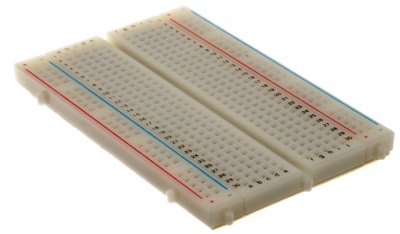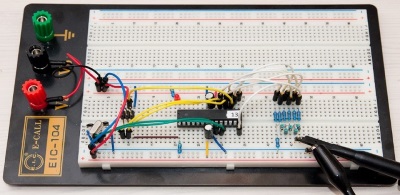What in the world is a breadboard?
That’s an excellent question and I’m glad you asked. To thoroughly answer this question we need to take a quick trip back in time to before the 1960’s. Back then if you wanted to create a circuit you had to use a technique called a wire wrap. It was a rat’s nest of wires and posts that got confusing and complicated.

Fast forward to the breadboard which, amusingly enough, received its name because people would prototype their bulky electronic circuits on their mom’s breadboard!
What is it used for?
Quite simply, a breadboard is used to make temporary circuits for prototyping designs sans soldering. They help simplify the prototyping process by allowing users to simply push a piece of wire in one of the holes. The board is lined by conductive metal on the bottom and metal clips that allow the user to quickly change around wires as needed. On a smaller board there are rows of holes where the wires go and any wire you put in a hole is electrically conducted to anything in that specific row. There is also a ravine that runs down the middle of the board which separates the board electrically.
Breadboard features
Mid-size boards are a little bit different in their design and they are also more commonly used. The difference is that the mid-size board has two rails on the longer sides of the board that carry the power instead of being located within the main interior of the board. The rails are labeled accordingly with colors and “+” and “-“.

Breadboards are also compatible with integrated circuits (ICs). You may recall the channel or ravine that runs down the middle of a breadboard. ICs are actually designed to bridge that gap — each leg, if you will, is unique, and you don’t want both sides connected to each other. The way these ICs are also referred to as a Dual In-line (DIP) package due to their efficient design.
You will notice numbering and letters around the rows of a breadboard — they are there to use as a guide during your build. Building circuits can be complicated sometimes, and these will help you keep track of what’s what.

There are also some breadboards that come with three larger binding posts for attaching various other external power sources. You can power a breadboard in a couple of different ways including by USB or even by way of connecting it to another breadboard. You can even adjust voltages allowing you infinite flexibility when building.
Breadboards are the starting point for some of our favorite gadgets and without them I might not be able to type this out on my computer!
Source: sparkfun
By Aaron LaBarbera
Advertisement
Learn more about Electronic Products Magazine





